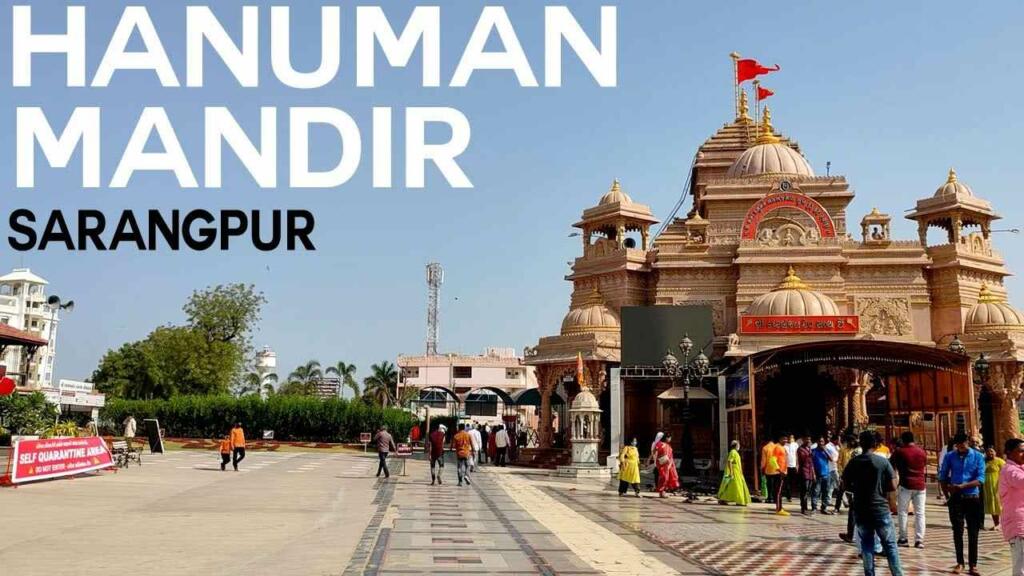Kasthabhanjan Hanumanji Sarangpur Temple – Overview
Shri Kasthabhanjan Dev Hanumanji Temple is situated at a place called Sarangpur in Gujarat. It is dedicated to Lord Hanuman, the main deity of the Hindus. This is the only temple of Swaminarayan ji, where there are no idols of Swaminarayan or Krishna as the main deity, but Shri Hanuman ji in the form of Kashtabhanjan is the main deity of this temple.
History of the Temple
The Kasthabhanjan Hanumanji Sarangpur Temple was built by Gopalanand Swami ji of the Swaminarayan trust. It is said about this temple that when the revenue coming to the king’s court of village Wagha Khachar decreased, then the people there were upset.
The people of this village were devotees of Lord Swaminarayan, so Gopalanand Swami decided to build a Hanumanji temple here to remove the miseries of the people of his community. He installed the idol of Hanuman ji on the day of Ashwini Vadi Pancham-Savant. People believe that the idol of Lord Hanuman ji located in this temple is so powerful that the evil spirits come out of the body of people affected by evil spirits just by looking at it.
Architecture of the Temple
Kasthabhanjan Hanumanji Sarangpur Temple is very famous for its architecture. The structure of the temple has been done according to the ancient Indian temples. The idol of Hanuman ji is sitting in the sanctum sanctorum of the temple. In which a female demon is standing with one leg up. This temple is looked after by the Swaminarayan Trust. The style and features of this temple are similar to those of ancient Hindu temples.
Also Read: Thirunallar Saneeshwara Bhagavan Temple, Timings, Travel Guide, History and How to reach
Place to visit near Kasthabhanjan Hanumanji Sarangpur Temple
Shri Ranchhodraiji Maharaj Temple
This temple is situated near the banks of the lake Gomti and built in the middle of Dakor’s market. This temple is covered with 8 domes and 24 bastions, in which the main dome is around 27 meters. A golden kalash and a white silk flag have been placed on top of it. The architecture of this temple is similar to the temples of Maharashtra.
Sabarmati Ashram Ahmedabad
The Sabarmati Ashram is just on the banks of the Sabarmati River in the town of Sabarmati in Gujarat. Which is about 4 km away from Town Hall. This is the residence of Mahatma Gandhi. When he was not in agitation or traveling in India, he lived in this ashram with followers including his wife Kasturba Gandhi and Vinoba Bhave.
Also Read: Wargal Temple, Telangana: Timings, Travel Guide, History and How to reach
Kankaria Lake
Kankaria Lake is the second largest lake in India. It is located in the southern part of Ahmedabad city. This lake was built during the Chalukya period in 1451 AD. Later a lakefront has been developed around this lake. Which has many public attractions like zoo, toy train, kids city, tethered balloon ride, water rides, water park, food stalls and entertainment facilities.
Bhadra Fort
Bhadra Fort Ahmedabad is situated in a walled area. Which was built by Ahmed Shah in 1411 AD. The fort is famous for its beautifully carved royal palaces, mosques and open spaces. It was renovated by the Archaeological Survey of India in 2014 as the cultural centre of the city.
Also Read: Girija Devi Temple, Ramnagar history, travel guide and how to reach
How to reach Kasthabhanjan Hanumanji Sarangpur Temple
By Air- The nearest airport to Sarangpur Hanuman Mandir is Sardar Vallabhbhai Patel International Airport which is at a distance of 8kms from Kasthabhanjan Hanumanji Sarangpur Temple. To reach this temple from here one can take taxi, bus or auto.
By Train- The nearest railway station to this temple is Botad Junction which is at a distance of 12 kms from this temple. You can take an auto taxi from here or reach the temple premises.
By Road- You can easily reach Sarangpur Hanuman Temple by road, from any city of Gujarat state through State Transport Corporation buses, private buses and taxis you can easily reach this temple.
Subscribe our TFI Dharma YouTube channel to watch Devotional videos because we are here to serve Sanatana Dhrama: TFIDHARMA
